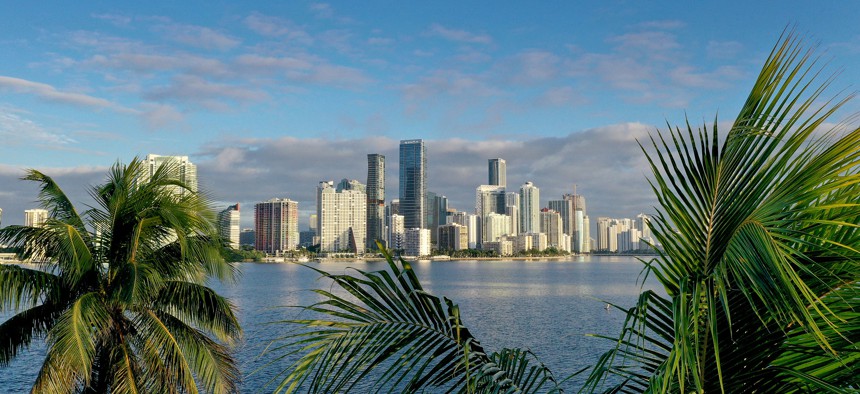Can Jane Gilbert beat the heat and save lives in South Florida?
With daily highs in the low 90s, Miami-Dade County’s “chief heat officer” has her work cut out.

View of palm trees framing the city skyline on October 27, 2021 in Miami. Some cities in Florida are encouraging the planting of canopy trees, including species such as gumbo limbo, oak, ash, elm, and sycamore, in place of palms. Florida's palm trees are the least effective at holding carbon, which contributes to temperature rise. Photo by Joe Raedle/Getty Images
It is perhaps a dubious achievement having to be “the world’s first chief heat officer,” as Architectural Digest called Jane Gilbert. But according to Miami-Dade Mayor Daniella Levine Cava, the person who appointed her last year, it’s not just about protecting people from extreme heat – it’s about saving lives. Gilbert came to the position after being Miami’s chief resilience officer, so she knows the challenges.
.jpg)
The Barnard College and Harvard Kennedy School graduate now is dealing with problems such as “heat islands” and a lack of trees, which offer shade but also clean the air. City & State spoke with Gilbert about what she does and how she hopes to make things less steamy in the city. (Questions and answers have been edited for brevity and clarity.)
What do you do as a heat officer?
My role is to make sure that more people are aware of the risks associated with extreme heat. We want people to know how to care for themselves. We are working not just toward dealing with climate change, we are looking at urban development and how we can develop as a community as climate change takes place. We ask, how can we cool roofs and improve our structures?
What do people in Miami-Dade face because of extreme heat?
Extreme heat is a silent killer and more people are dying and suffering from heat-related problems. Recently there were 90 deaths in Washington and Oregon because of heat. Over the past 20 years, about 160,000 people have died worldwide because of heat. We have seen a bump in the deaths caused by heat … and we are working with community-based groups to help lower-income communities deal with the heat.
What are things individuals and communities can do?
People need to hydrate and bring water when they go outside. They’re exerting energy when they work or play outside. People should wear lighter clothing and take a break every couple of hours. Outdoor activities should be in the early morning or evening when temperatures are cooler. Many people are not drinking enough water. For the long term, we need to make homes more energy efficient. We need to use more efficient light bulbs. We need to paint houses and buildings lighter colors. It’s important to plant trees to provide shade …. trees will cool the surrounding area. They also help with storm water and clean the air we breathe.
What can governments do?
We are looking at sustainable building ordinances to require buildings be built with cooler roofs. Paint the roofs white … It’s also important to have more health warnings. People need to understand that they are in danger when the heat index increases, so we need to engage (more) people regarding climate change and the dangers of increased heat. We need to work with employers who hire people to work outside. We might have to encourage construction companies to have their personnel work in the early morning hours and then the evening when the temperatures are lower … At the federal level, there should be interagency agreements between the Environmental Protection Agency, Health and Human Services and the National Oceanic Atmospheric Administration to work on the increase in heat.
David Volz has been a reporter for numerous community news publications throughout South Florida over the past two decades, as well as the South Florida Sun-Sentinel, Miami Herald and South Florida Business Journal. He covers city government, schools, sports, culture, faith groups and workplaces.
NEXT STORY: This week’s biggest Winners & Losers